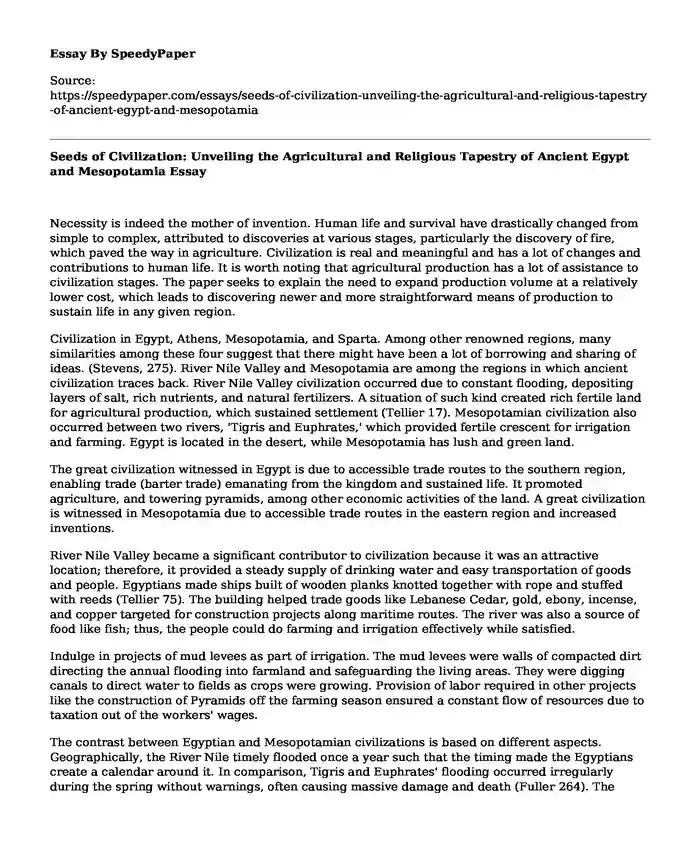Necessity is indeed the mother of invention. Human life and survival have drastically changed from simple to complex, attributed to discoveries at various stages, particularly the discovery of fire, which paved the way in agriculture. Civilization is real and meaningful and has a lot of changes and contributions to human life. It is worth noting that agricultural production has a lot of assistance to civilization stages. The paper seeks to explain the need to expand production volume at a relatively lower cost, which leads to discovering newer and more straightforward means of production to sustain life in any given region.
Civilization in Egypt, Athens, Mesopotamia, and Sparta. Among other renowned regions, many similarities among these four suggest that there might have been a lot of borrowing and sharing of ideas. (Stevens, 275). River Nile Valley and Mesopotamia are among the regions in which ancient civilization traces back. River Nile Valley civilization occurred due to constant flooding, depositing layers of salt, rich nutrients, and natural fertilizers. A situation of such kind created rich fertile land for agricultural production, which sustained settlement (Tellier 17). Mesopotamian civilization also occurred between two rivers, 'Tigris and Euphrates,' which provided fertile crescent for irrigation and farming. Egypt is located in the desert, while Mesopotamia has lush and green land.
The great civilization witnessed in Egypt is due to accessible trade routes to the southern region, enabling trade (barter trade) emanating from the kingdom and sustained life. It promoted agriculture, and towering pyramids, among other economic activities of the land. A great civilization is witnessed in Mesopotamia due to accessible trade routes in the eastern region and increased inventions.
River Nile Valley became a significant contributor to civilization because it was an attractive location; therefore, it provided a steady supply of drinking water and easy transportation of goods and people. Egyptians made ships built of wooden planks knotted together with rope and stuffed with reeds (Tellier 75). The building helped trade goods like Lebanese Cedar, gold, ebony, incense, and copper targeted for construction projects along maritime routes. The river was also a source of food like fish; thus, the people could do farming and irrigation effectively while satisfied.
Indulge in projects of mud levees as part of irrigation. The mud levees were walls of compacted dirt directing the annual flooding into farmland and safeguarding the living areas. They were digging canals to direct water to fields as crops were growing. Provision of labor required in other projects like the construction of Pyramids off the farming season ensured a constant flow of resources due to taxation out of the workers' wages.
The contrast between Egyptian and Mesopotamian civilizations is based on different aspects. Geographically, the River Nile timely flooded once a year such that the timing made the Egyptians create a calendar around it. In comparison, Tigris and Euphrates' flooding occurred irregularly during the spring without warnings, often causing massive damage and death (Fuller 264). The dependency on geography for food production caused the creation of religions.
Religion was polytheistic between the two countries. Civilizations differed in their interpretation of gods. Healthy relationships with the gods were considered significant since they ensured surplus harvest and the best opportunities for survival (Rasool 30). Egypt was optimistic about the gods. They were deemed harsh, yet they gave people wisdom and justice as gifts. The Egyptian afterlife was supposed to be a better continuation of life on Earth. On the other hand, Mesopotamians thought their unpredictable since they had a rough time with the flooding, and there was only a land of no return after death.
Works Cited
Fuller, Dorian Q., and Chris J. Stevens. "Between domestication and civilization: the role of agriculture and arboriculture in the emergence of the first urban societies." Vegetation history and archaeobotany 28.3 (2019): 263-282.
Rector, Rebecca Kraft. The Early River Valley Civilizations. The Rosen Publishing Group, Inc, 2016.
Tellier, Luc-Normand. "From the Beginnings of Agriculture and Urbanization to the First Urbexplosions." Urban World History. Springer, Cham, 2019. 15-80.
Rasool, Ahmed Arazoo. "Comparative study of the function of goddesses in Mesopotamian civilizations, Elam, Iran, India, Greece, and Egypt." Journal of Process Management. New Technologies 7.2 (2019): 24-34.
Cite this page
Seeds of Civilization: Unveiling the Agricultural and Religious Tapestry of Ancient Egypt and Mesopotamia. (2024, Jan 18). Retrieved from https://speedypaper.com/essays/seeds-of-civilization-unveiling-the-agricultural-and-religious-tapestry-of-ancient-egypt-and-mesopotamia
Request Removal
If you are the original author of this essay and no longer wish to have it published on the SpeedyPaper website, please click below to request its removal:
- Jihadi Salafism Essay Sample
- Montreaux Initiative Essay Example
- Free Essay Example: Doctrine and Politics of the Early Church
- Free Paper Describing Some Events of American History
- Free Essay: The Book of Ephesians
- Paper Example. Fall of Rome and Rise of Christianity
- 1980s Events in the American History - Essay Example
Popular categories





